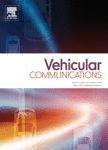版权所有:内蒙古大学图书馆 技术提供:维普资讯• 智图
内蒙古自治区呼和浩特市赛罕区大学西街235号 邮编: 010021

作者机构:Chongqing Univ Posts & Telecommun Sch Comp Sci & Technol Chongqing 400065 Peoples R China East China Res Inst Comp Technol Shanghai 201800 Peoples R China Hangzhou Dianzi Univ Sch Comp Sci Hangzhou 310018 Peoples R China
出 版 物:《VEHICULAR COMMUNICATIONS》 (Veh. Commun.)
年 卷 期:2025年第52卷
核心收录:
学科分类:0810[工学-信息与通信工程] 08[工学] 0823[工学-交通运输工程]
主 题:Unmanned aerial vehicles (UAVs) Clustering algorithm Multi-objective particle swarm optimization (MOPSO) Flying ad-hoc networks (FANETs)
摘 要:Unmanned aerial vehicles (UAVs) are an emerging technology with the potential to be used in industries and various sectors of human life to provide a wide range of applications and services, significantly enhancing its applicability in different fields. When a UAV swarm performs complex tasks, flying Ad-hoc networks (FANETs) based on cluster structures have become a key research topic in the field of topology control due to their strong scalability and low routing overhead. However, current research mainly concentrates on the selection of the cluster head (CH), considering all UAVs within the CH s communication radius as cluster members (CMs), often neglecting whether the cluster can effectively accomplish the task, thereby potentially leading to mission failure. To overcome this problem, this paper innovatively proposes a task-driven clustering (TDC-MOPSO) algorithm based on improved multi-objective particle swarm optimization (MOPSO) for clustering-structure- based heterogeneous FANETs, which introduces the transfer function to improve the search range of particles and the mutation mechanism to avoid falling into local optima, and a more reasonable fitness function is designed to select CHs. The simulation results indicate that the proposed TDC-MOPSO algorithm dramatically improves the task completion rate by up to about 41.32% and extends the node lifetime by up to about 50.12% compared to traditional clustering algorithms. Meanwhile, the TDC-MOPSO algorithm improves the task completion rate by up to about 11.02% compared to other mopso-based algorithms. Furthermore, the TDC-MOPSO algorithm obtains more clustering solutions with higher average energy, less waste of resources, less CH handover rate, and less routing overhead in simulation. The proposed algorithm is also verified in a real-life scenario, which also effectively supports the completion of the task. All of which demonstrates that the TDC-MOPSO algorithm enhances the efficiency of task execution while